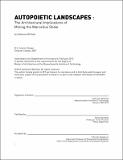Autopoietic landscapes : the architectural implications of mining the Marcellus Shale
Author(s)
Winfield, Catherine (Catherine Anne)
DownloadFull printable version (117.4Mb)
Alternative title
Architectural implications of mining the Marcellus Shale
Other Contributors
Massachusetts Institute of Technology. Department of Architecture.
Advisor
Sheila Kennedy.
Terms of use
Metadata
Show full item recordAbstract
Hydraulic fracturing, a form of natural gas extraction, is a process deeply embedded in the networks of politics, power, economics, energy, infrastructure, and land use. Hydraulic fracturing has become a standard practice by energy companies looking to capitalize of dwindling resources. This coupled with the discovery of 2.2 trillion cubic feet of natural gas within the United States has expanded the practice of hydraulic fracturing at an alarming rate. This thesis explores the impacts of this process through the design of a series of site interventions based on the conceptual exploitation of its current failures. The failures of the system exploited include the deregulation of the industry and the risk that such large scale toxic processes create. These site interventions varying in scale, impact, execution, and discipline. As fracking proliferates, these interventions become more legible across the landscape, indicators of contamination. This thesis does not seek to demonize the practice of hydraulic fracturing. Rather this thesis seeks to produce a "fracked urbanism" which has embedded these atmospheric indicators, reflecting the multivalent impacts of hydraulic fracturing. Therefore, creating an autopoietic landscape, a landscape whose architectural, technological and infrastructural components ebb and flow with the presence of the fracking's failures.
Description
Thesis (M. Arch.)--Massachusetts Institute of Technology, Dept. of Architecture, 2013. This electronic version was submitted by the student author. The certified thesis is available in the Institute Archives and Special Collections. Cataloged from student-submitted PDF version of thesis. Includes bibliographical references (p. 114-115).
Date issued
2013Department
Massachusetts Institute of Technology. Department of ArchitecturePublisher
Massachusetts Institute of Technology
Keywords
Architecture.